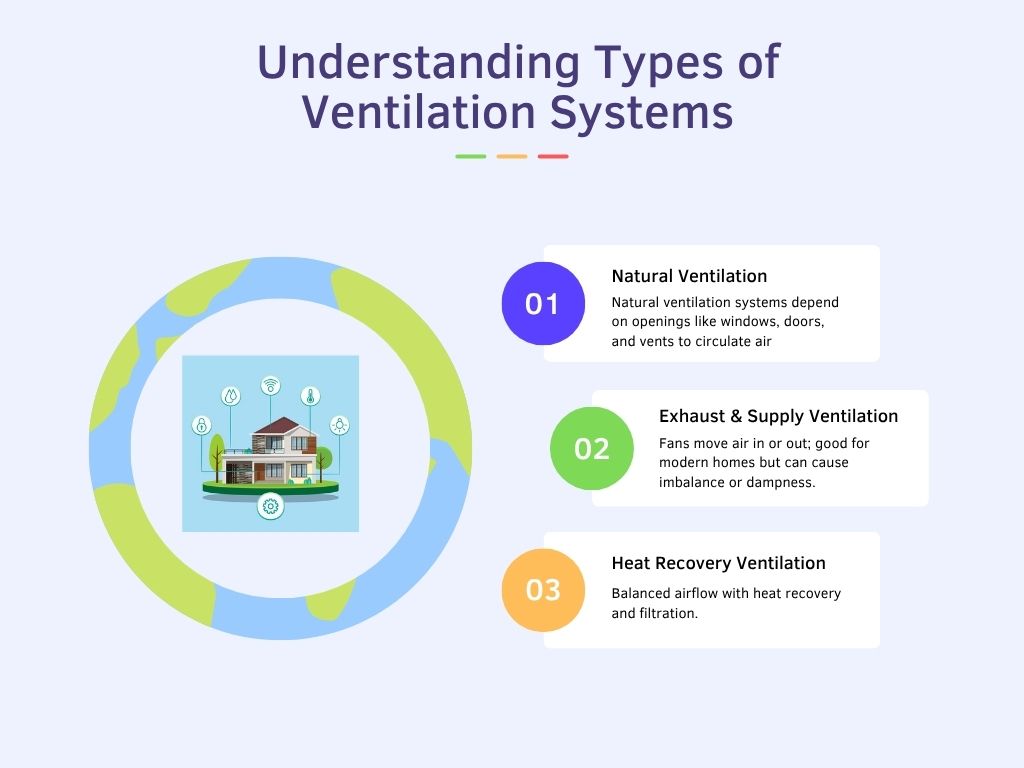A home is more than four walls and a roof. A house needs fresh air just like you do. Good air quality inside your home helps keep you healthy. It enables you to sleep better, feel better, and worry less about damp or mold. Selecting the right home ventilation system to use is a significant step toward achieving comfort and energy savings.
You want clean, dry air all year round without wasting money or power. Some people do not think about it until they start having problems. But you can stop issues before they start. This guide will help you pick a ventilation system that works for your space, fits your needs, and does not use more money than needed. You will find answers and clear steps so you feel calm and sure about your air at home.
Understanding Types of Home Ventilation Systems
Not every house uses the same kind of home ventilation systems. Some work just by opening a window. Some use fans and ducts that move air in and out. Some are built to save as much heat as possible. You want air that feels fresh, smells clean, and does not drive your bills too high. Here are the main choices.

- Natural Ventilation
This is the easiest way to get fresh air. Just open a window, vent, or trickle slot. Some houses have wall vents or air bricks to help. In summer, it feels nice. You hear birds, feel a soft breeze, and smell the garden. In old houses, this kind of air change is enough. Many people like the simple feel of it.
But windows do not help on days with no wind. You may get cold air in winter. Your house loses heat, so bills go up. Some bugs or pollen may fly in. Modern, airtight homes may not get enough fresh air this way.
- Exhaust and Supply Ventilation Systems
These systems use fans to move air. Exhaust systems suck air out, usually from wet rooms like the kitchen or bathroom. This pulls in new air (through vents or leaks). Supply systems push fresh air in and let stale air leak out again.
Both types are stronger than natural airflow. You can use them in newer homes. But if gaps are sealed tight, they struggle to keep up. Exhaust-only systems might bring in pollen or dust you do not want. Supply-only systems can become damp if air flows the wrong way.
- Balanced Ventilation and Heat Recovery Ventilators (HRVs)
Balanced systems have fans for both in and out. They move the same amount of air each way. They keep pressure even, so you do not get cold spots or drafts. A heat recovery ventilator takes stale air out and pulls fresh air in at the same time. It uses a special core that warms up the fresh air with the heat from the old air. This is called mechanical ventilation heat recovery.
This system is very good for your health. Fresh air is always coming in, but your house keeps the heat. You save money and feel warmer in winter. The air is filtered and clean. These ventilation systems are the best for energy savings and good air, but they cost more to put in.
How to Choose the Right Home Ventilation System
Every family and house is different. What works for a small bungalow may not work for a big flat or a busy house with children and pets. Picking a good ventilation system for home comfort involves these steps.
- Home and Climate Assessment
Start by looking at your home. Walk through each room. Ask yourself—
- How big is your home? More rooms mean more air to move.
- Are there people or pets in every room?
- Does your house feel stuffy, damp, or musty?
- Is there condensation on windows or mold in the bathroom?
- Is it cold in some rooms and too hot in others?
- Do you live in a dry, windy area or a damp, still one?
- Are your windows often closed for noise or safety?
Houses in cold climates benefit from a heat recovery ventilator, which keeps warm air inside. In mild places, you might use natural systems most of the year.
- Comparing Costs and Energy Efficiency
Think about the money you have now and the money you want to save later. Look at
- Natural ventilation: It costs almost nothing, but it loses heat. Bills go up in winter.
- Exhaust or supply systems: Cheap to fit, mid-range to run, some heat loss.
- Balanced mechanical ventilation heat recovery: Expensive up front, big long-term savings. Uses little electricity, saves on heating and cooling. Pays off over time.
A heat recovery ventilator gives constant, gentle fresh air. You spend less on heating. The air feels even and dry. Small homes or flats might need a simple exhaust fan. Large or airtight houses often need HRVs.
- Installation, Maintenance, and Professional Advice
Not every system is easy to fit. Some need holes cut in walls, ducts run in the loft, or special filters. Think about
- Can it be added to your home without too much mess?
- Is there space for ducts, fans, or a heat exchanger?
- Are there filters that need to be cleaned or changed?
- Is someone able to service the system once a year?
Always talk to a specialist if you are not sure. They will guide you, assess your home and needs, and then explain what is best for your budget, comfort, and air quality.
The Bottom Line
Breathing easy at home is one of the best gifts you can give yourself. Picking the right ventilation system for home comfort is about more than stopping mold or saving on bills. It is about feeling at peace in your space. Remember, homes with proper airflow feel better, work safer, and save money in the long run. Children, pets, and adults all feel the difference.
Check your air now. Think about your house—how it feels, smells, and sounds. Look at your money plan. If rooms still feel stuffy or you want to keep more warmth without spending more, a heat recovery ventilator or other system may be best. Get advice if you need it. Make your next step clear and simple. Good air means a happier, healthier home for everyone.


















